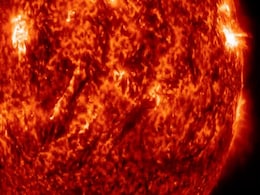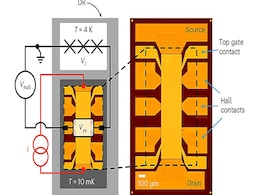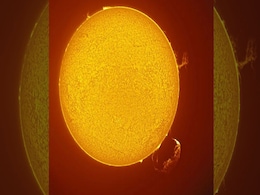Magnetic Fields
- All
- News
-

Uranus and Neptune May Be Rock-Dominated Planets, Study Suggests
- Saturday December 13, 2025
Uranus and Neptune may not be true ice giants after all. New research using advanced hybrid simulations suggests the distant planets could be dominated by rocky material rather than water-rich ices. The findings challenge decades of planetary models and may help explain the planets’ unusual, non-dipolar magnetic fields. Scientists say future dedi...
-
 www.gadgets360.com
www.gadgets360.com
-

Uranus and Neptune May Be Rocky Worlds Not Ice Giants, New Research Shows
- Thursday December 11, 2025
A new analysis challenges decades-old assumptions about Uranus and Neptune, revealing that both planets may contain far more rock than icy materials. These findings help explain their strange magnetic fields and show that traditional "ice giant" models may be incomplete. Scientists say only dedicated future missions can uncover the true interior ma...
-
 www.gadgets360.com
www.gadgets360.com
-

ESA Telescopes Capture Ultra-Fast Winds Blasting From Distant Supermassive Black Hole
- Thursday December 11, 2025
Astronomers have witnessed an extraordinary black hole outburst in the galaxy NGC 3783, where material was blasted into space at nearly 20% the speed of light. Triggered by an intense X-ray flare, the ultra-fast winds reveal how supermassive black holes can violently shape their surroundings and influence the evolution of entire galaxies.
-
 www.gadgets360.com
www.gadgets360.com
-

Massive Sunspot Complex on the Sun Raises Risk of Strong Solar Storms
- Tuesday December 9, 2025
A massive sunspot complex has appeared on the Sun, covering an area comparable to the legendary Carrington Event region. Known as AR 4294-96, the active cluster features highly tangled magnetic fields that could unleash powerful solar flares and geomagnetic storms, potentially disrupting satellites, power grids, and global communications if Earth-d...
-
 www.gadgets360.com
www.gadgets360.com
-

Ancient Fossils Show Animals Used Earth's Magnetic Field For GPS-Like Navigation
- Sunday November 30, 2025
- Science |
They observed that the structure of tiny magnetic fields generated by the rotating electrons indicates that the organisms that created these fossils possessed magnetoreception.
-
 www.ndtv.com
www.ndtv.com
-

Watch: Astronaut Shares Breathtaking View Of Southern Lights As Seen From Space
- Wednesday November 26, 2025
- Science |
The aurora australis is caused by charged particles from the solar wind interacting with the Earth's magnetic field and atmosphere.
-
 www.ndtv.com
www.ndtv.com
-

Scientists Recreate Cosmic ‘Fireballs’ in Lab to Solve Mystery of Missing Gamma Rays
- Wednesday November 5, 2025
Scientists recreated cosmic plasma beams at CERN to study why certain gamma rays vanish in space. The results showed the beams remain stable, suggesting ancient intergalactic magnetic fields, not beam collapse, hide the signals. The discovery provides new insight into cosmic jets and the universe’s earliest magnetic traces.
-
 www.gadgets360.com
www.gadgets360.com
-

Cannibal Solar Storm May Trigger Auroras as Powerful Geomagnetic Storm to Hit Earth Soon
- Tuesday September 2, 2025
Between Sept. 1–2, Earth will be struck by a powerful geomagnetic storm caused by a rare “cannibal” solar eruption. The event formed when a fast coronal mass ejection (CME) overtook and consumed an earlier one, creating a stronger, chaotic cloud. As this storm interacts with Earth’s magnetic field, it may produce vivid auroras visible far b...
-
 www.gadgets360.com
www.gadgets360.com
-

Researchers Discover New Plasma Wave in Jupiter’s Auroral Skies
- Monday August 25, 2025
Scientists at the University of Minnesota Twin Cities have detected a new plasma wave in Jupiter’s aurora using NASA’s Juno spacecraft. The finding, published in Physical Review Letters, reveals how Jupiter’s magnetic field shapes auroral activity differently from Earth. The study opens new directions for understanding planetary auroras and m...
-
 www.gadgets360.com
www.gadgets360.com
-

Single Quantum Device Measures Amperes, Volts, and Ohms in New Discovery
- Saturday August 23, 2025
Scientists at NIST have developed a quantum device that measures amperes, volts, and ohms within a single system for the first time. Reported in Nature Electronics, the breakthrough uses two integrated quantum standards to achieve unmatched accuracy. The innovation could transform electrical measurements across research, technology, and diagnostics...
-
 www.gadgets360.com
www.gadgets360.com
-

Rare Giant Solar Tornado and Plasma Eruption Captured Together on the Sun
- Sunday August 24, 2025
A Romanian researcher captured a rare sight on the Sun — a giant solar tornado alongside a massive plasma eruption. Both events, driven by magnetic field changes, highlight the Sun’s extreme activity during solar maximum. Luckily, the eruption’s CME is not headed toward Earth.
-
 www.gadgets360.com
www.gadgets360.com
-

Uranus and Neptune May Be Rock-Dominated Planets, Study Suggests
- Saturday December 13, 2025
Uranus and Neptune may not be true ice giants after all. New research using advanced hybrid simulations suggests the distant planets could be dominated by rocky material rather than water-rich ices. The findings challenge decades of planetary models and may help explain the planets’ unusual, non-dipolar magnetic fields. Scientists say future dedi...
-
 www.gadgets360.com
www.gadgets360.com
-

Uranus and Neptune May Be Rocky Worlds Not Ice Giants, New Research Shows
- Thursday December 11, 2025
A new analysis challenges decades-old assumptions about Uranus and Neptune, revealing that both planets may contain far more rock than icy materials. These findings help explain their strange magnetic fields and show that traditional "ice giant" models may be incomplete. Scientists say only dedicated future missions can uncover the true interior ma...
-
 www.gadgets360.com
www.gadgets360.com
-

ESA Telescopes Capture Ultra-Fast Winds Blasting From Distant Supermassive Black Hole
- Thursday December 11, 2025
Astronomers have witnessed an extraordinary black hole outburst in the galaxy NGC 3783, where material was blasted into space at nearly 20% the speed of light. Triggered by an intense X-ray flare, the ultra-fast winds reveal how supermassive black holes can violently shape their surroundings and influence the evolution of entire galaxies.
-
 www.gadgets360.com
www.gadgets360.com
-

Massive Sunspot Complex on the Sun Raises Risk of Strong Solar Storms
- Tuesday December 9, 2025
A massive sunspot complex has appeared on the Sun, covering an area comparable to the legendary Carrington Event region. Known as AR 4294-96, the active cluster features highly tangled magnetic fields that could unleash powerful solar flares and geomagnetic storms, potentially disrupting satellites, power grids, and global communications if Earth-d...
-
 www.gadgets360.com
www.gadgets360.com
-

Ancient Fossils Show Animals Used Earth's Magnetic Field For GPS-Like Navigation
- Sunday November 30, 2025
- Science |
They observed that the structure of tiny magnetic fields generated by the rotating electrons indicates that the organisms that created these fossils possessed magnetoreception.
-
 www.ndtv.com
www.ndtv.com
-

Watch: Astronaut Shares Breathtaking View Of Southern Lights As Seen From Space
- Wednesday November 26, 2025
- Science |
The aurora australis is caused by charged particles from the solar wind interacting with the Earth's magnetic field and atmosphere.
-
 www.ndtv.com
www.ndtv.com
-

Scientists Recreate Cosmic ‘Fireballs’ in Lab to Solve Mystery of Missing Gamma Rays
- Wednesday November 5, 2025
Scientists recreated cosmic plasma beams at CERN to study why certain gamma rays vanish in space. The results showed the beams remain stable, suggesting ancient intergalactic magnetic fields, not beam collapse, hide the signals. The discovery provides new insight into cosmic jets and the universe’s earliest magnetic traces.
-
 www.gadgets360.com
www.gadgets360.com
-

Cannibal Solar Storm May Trigger Auroras as Powerful Geomagnetic Storm to Hit Earth Soon
- Tuesday September 2, 2025
Between Sept. 1–2, Earth will be struck by a powerful geomagnetic storm caused by a rare “cannibal” solar eruption. The event formed when a fast coronal mass ejection (CME) overtook and consumed an earlier one, creating a stronger, chaotic cloud. As this storm interacts with Earth’s magnetic field, it may produce vivid auroras visible far b...
-
 www.gadgets360.com
www.gadgets360.com
-

Researchers Discover New Plasma Wave in Jupiter’s Auroral Skies
- Monday August 25, 2025
Scientists at the University of Minnesota Twin Cities have detected a new plasma wave in Jupiter’s aurora using NASA’s Juno spacecraft. The finding, published in Physical Review Letters, reveals how Jupiter’s magnetic field shapes auroral activity differently from Earth. The study opens new directions for understanding planetary auroras and m...
-
 www.gadgets360.com
www.gadgets360.com
-

Single Quantum Device Measures Amperes, Volts, and Ohms in New Discovery
- Saturday August 23, 2025
Scientists at NIST have developed a quantum device that measures amperes, volts, and ohms within a single system for the first time. Reported in Nature Electronics, the breakthrough uses two integrated quantum standards to achieve unmatched accuracy. The innovation could transform electrical measurements across research, technology, and diagnostics...
-
 www.gadgets360.com
www.gadgets360.com
-

Rare Giant Solar Tornado and Plasma Eruption Captured Together on the Sun
- Sunday August 24, 2025
A Romanian researcher captured a rare sight on the Sun — a giant solar tornado alongside a massive plasma eruption. Both events, driven by magnetic field changes, highlight the Sun’s extreme activity during solar maximum. Luckily, the eruption’s CME is not headed toward Earth.
-
 www.gadgets360.com
www.gadgets360.com
















